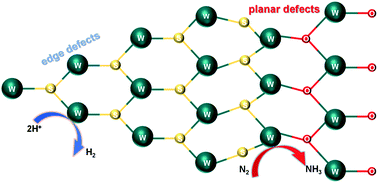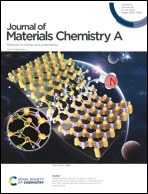Strain induced rich planar defects in heterogeneous WS2/WO2 enable efficient nitrogen fixation at low overpotential†
Abstract
Suppression of the competitive hydrogen evolution reaction (HER) and creation of new active sites have been considered to be the most effective methodology to design efficient electrocatalysts for the nitrogen reduction reaction (NRR). Here, we report a heterogeneous WS2/WO2 electrocatalyst with abundant planar defects at the heterointerface ascribed to the strain effect induced by the mismatched lattice spacing between WS2 and WO2, which enables efficient electrocatalysis toward the NRR with a faradaic efficiency of 13.5% and an NH3 yield rate of 8.53 μgNH3 h−1 mgcat.−1 at −0.1 V vs. RHE in acidic medium compared to bare WS2 with a faradaic efficiency of 7.87% and an NH3 yield rate of 6.99 μgNH3 h−1 mgcat.−1. The superior NRR electrocatalytic activity of heterostructured WS2/WO2 is attributed to the introduction of WO2 effectively impeding the HER catalysis because of the blocking of edge defects in WS2 and simultaneously creating planar defects at the WS2/WO2 heterointerface as active sites for stable NRR catalysis. The extraordinary NRR electrocatalytic activity of WS2/WO2 is further confirmed by NMR measurements and density functional theory (DFT) calculations demanding comparably lower uphill free energy for the rate-determining step of NRR catalysis, i.e. formation of NNH species. This work offers useful information for constructing efficient NRR electrocatalysts.



 Please wait while we load your content...
Please wait while we load your content...